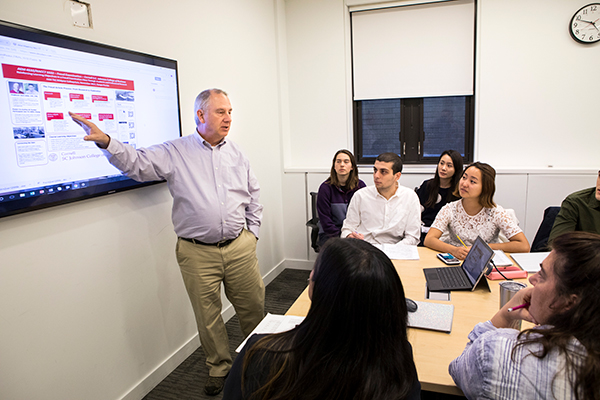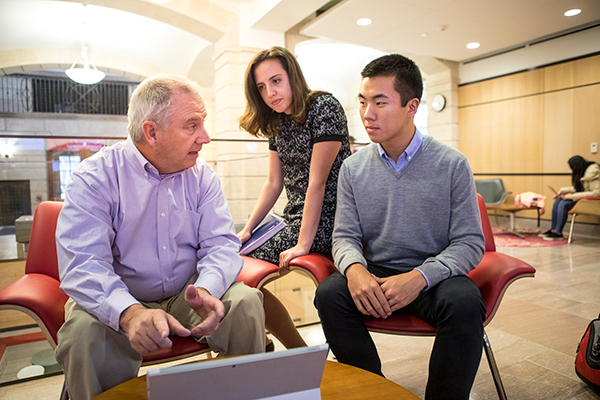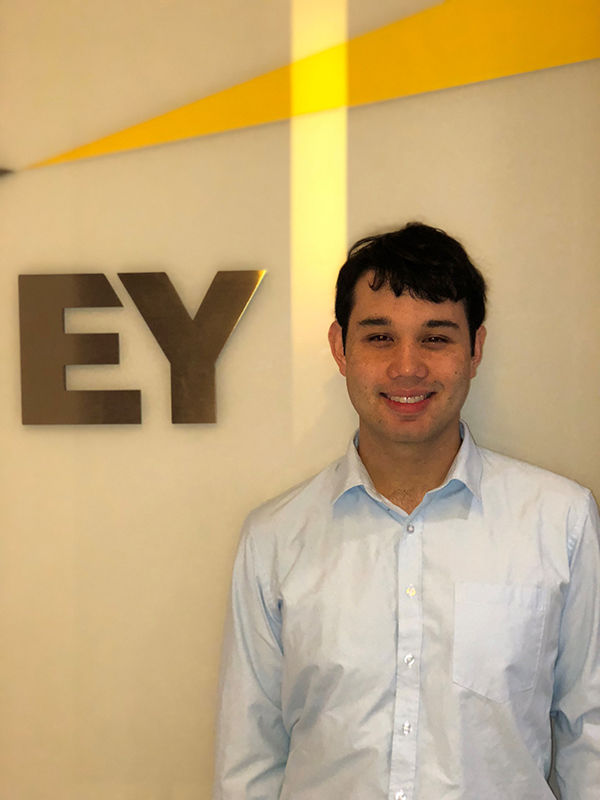What makes a fraudster steal—and how to prevent it

While fraudsters behind massive accounting schemes like Bernie Madoff may grab headlines, small business fraud can do far greater damage, observes Jack Little, professor of practice in the Dyson School at Cornell’s SC Johnson College of Business.
Companies with fewer than 100 employees had the highest frequency of fraud and the largest losses, according to the Association of Certified Fraud Examiners’ (ACFE) recent Report to the Nations on Occupational Fraud and Abuse. Most of that money is never recouped. “It’s a huge problem,” Little said.
Little, who teaches the course Fraud Examination to about 20 students each spring, is both a certified public accountant and a certified fraud examiner. A managing partner at a successful accounting practice for 25 years before selling the business and joining Dyson’s accounting faculty, he also teaches Financial Accounting to a large group of Dyson sophomores each fall.
“What I bring to the students is that experience of working in the real world of full financial accounting as well as fraud discovery,” said Little, whose first fraud case as a CPA involved a Cornell student who stole money from his fraternity. Little made the discovery while doing the fraternity’s taxes. He then informed its leaders and helped them get a commitment for restitution.
The course begins with a look at a high-profile fraud involving the Krispy Kreme donut company. “It gets the students’ attention, because they probably sold Krispy Kremes for school fundraisers when they were younger and ate plenty of them along the way,” commented Little.
The cautionary tale shows how the once high-flying donut maker inflated its earnings, as revealed in an internal inquiry sent to the U.S. Securities and Exchange Commission in August 2005, and lost big as a result.
To help his students gain a deeper understanding of accounting fraud, Little discusses the many kinds—everything from check tampering to skimming funds to expense reimbursement schemes and more. He also brings in guest speakers, who talk about fraud from their different perspectives.

“We have fraud victims, such as the president of a fire company defrauded by a bookkeeper,” Little said. “We’ve brought in an assistant district attorney; an auditor from Cornell; a county court judge; examiners; IRS agents; a law enforcement agent, who tells how suspects are interviewed; an assistant district attorney, who talks about the judicial process; and a judge, who explains just how much consideration is involved in arriving at a fair sentence.”
Little’s students also form teams that research an actual fraud case of their choice and write reports on them, using the contributors’ guidelines of Fraud Magazine—a publication of the ACFE. The best ones have been published there.
“All of the students must have some kind of original investigative evidence,” Little said. “They have to interview a perpetrator, a victim, or a law enforcement agent, get court records, or file a Freedom of Information Law request.”

“This course was one of my favorites at Cornell, and I ended up TAing for it my second year,” said Megan Sutton ’17, who now works in the financial services division of the Business Advisory Program at Ernst & Young (EY) in New York City. “Not only did we get to pick our project, do all the investigating, and lead the paper in the direction that we felt fit, but when I interviewed for jobs I used it as an example of working well on a team and getting results.”
The paper that Sutton co-authored with Little, “Letters from prison tell the story of a $1.65 million insurance fraud,” was published in the July–August 2017 issue of Fraud Magazine. It recounts how the owner of a hearing-aid supply business in central New York submitted fraudulent insurance claims to the state for clients who actually had no hearing impairments. Accepting reimbursement fees for the unneeded products netted him as much as $1.65 million.
Sutton and Little corresponded with the perpetrator, now in state prison, to find out why he did it—and learned that greed and the chance to become more successful were motivators. Chastened by his harsh jail sentence, however, he wrote that he now thought it was important to “make sure what you do is legit, and never trade your morals for quick money. Hard work is best.”
Little asks his students to identify the “fraud triangle,” the three elements that criminologists say are needed for a crime to take place: pressure, opportunity, and rationalization.
“Pressure is what drives a fraud,” he explained. “It can be anything that creates a demand for more money—a gambling or drug problem, a family health problem or anything else that might prompt people to commit criminal acts that they wouldn’t ordinarily do.
“Opportunity is what allows a fraud to happen,” he continued. “If there’s opportunity for someone to commit fraud at a company, it suggests that fraud prevention controls are either not in place or not being followed.
“And rationalization allows perpetrators to live with themselves after committing a crime, ” he concluded. “To justify what they did, they may tell themselves things like, ‘people don’t treat me well here, so doing this is okay,’ when they know it’s not okay.”
The best way to prevent fraud, Little asserts, is for companies to make sure that their “tone at the top,” the message they broadcast to their employees, reflects zero tolerance for illegal behavior. “They must have strong anti-fraud and anti-abuse policies and internal controls and they must actively monitor,” he said. Most importantly, “If they find [potential wrongdoing], they need to investigate and prosecute to the fullest extent possible.”

“Jack definitely has taken a vested interest in the accounting students and making sure that when they leave Cornell they are where they need to be in terms of their careers,” said Jason Grossman ’16, who took Little’s fraud examination course the first time it was offered, in spring 2015, and served as its TA the following year.
Grossman, now a senior analyst in product control in Goldman Sachs’s finance department, said, “Jack taught us to develop our professional skepticism, to challenge things that seem to be not wrong per se but a little bit off, not meeting your expectations. That’s been a useful skill at work.” An advisee of Little’s, he researched, co-wrote, and published two studies of real-life fraud in Fraud Magazine when he was a Dyson student.
Their first article, titled “Trusted assistant steals $365,000 from not-for-profit” and published in the July–August 2015 issue, involved a fraudulent check scheme by an employee at a private nonprofit. The second article, “Roving signature stamp: poor controls cost transit entity $250,000,” published in January–February 2016, was about an employee at a different private nonprofit who submitted fictitious invoices and used a higher-up’s signature stamp to pay them.

College of Arts and Sciences grad Greg Chu ’16, now working in the fraud investigative division at EY Dallas, said, “Jack’s course was a good transition into that field, because it gave you a taste of what you would do in real life. Researching an actual fraud case, we went through pages and pages of legal documents to produce a final product that was polished and comprehensible. It was exciting, like solving a puzzle, and it gave me an edge during job recruitment.”
Gabrielle Schiffmiller ’16, now at EY in New York City, was a TA for several of Little’s courses, including Fraud Examination. “It was a great experience,” she said. “I learned from the guest speakers Jack brought in, and I got to do an independent fraud study and write-up with him that got published in the November–December 2016 issue of Fraud Magazine.”
The study, “Misplaced trust: church leaders drain at least $673,000 from accounts,” concerned significant fraud by two volunteers at a small-town church in central New York. “It was eye-opening to see how people you trust can lead you in the wrong direction,” Schiffmiller said. “How that translates now is I’m in audit, specializing in asset management, so determining whether there are fraud risks is part of my everyday job.”
Little said that teaching in an environment like the Dyson School has gotten him more interested in the behavioral aspects of fraud. “We have a lot of behavioral economists here, and I have learned a lot from them,” he noted. “Applying their approach to understanding why people commit fraud and sharing that with my students is exciting. Teaching them to think about information differently—for example, taking into account any ulterior motives the people who provided the information might have had—may make the students more professionally skeptical, which is what I’d like them to be.”
— Written by Linda Brandt Myers, a freelance writer for the Cornell
SC Johnson College of Business
